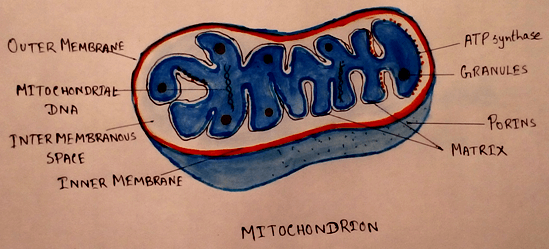Explain about Mitochondria
The term mitochondria can be broken into mito and chondrion.
The term “mito “ means fibril and” chondrion “means granule.
Definition of mitochondria - The rod like filamentous, spherical or oval, double membrane bound cytoplasmic organelles of eukaryotic cells, which are concerned with cellular respirationis called mitochondria.
It was first observed by Kolliker in 1850 in the striated muscle cells as granular structures. Mitochondria was described by Flemming in 1882 as a thread like structure and named as fila. In 1892 Altman described it as bioplast.In 1897 Benda finally introduced the name mitochondria.
Distribution – Mitochondria are found in all eukaryotic cell except mature RBC of mammalian cell. It is distributed throughout the cytoplasm of the cell ,mainly concentrated to the muscular tissue, renal tubular cell, contractile element. In case of bacteria they possesses mesosome which is substitution of the mitochondria. Cell s of eukaryotes which are associated with secretion are contain large number of mitochondria.
Origin – It is believed that mitochondria is produced from preexisting mitochondria, endoplasmic reticulum, plasma membrane,nuclear membrane etc. It’s life span is only 5to 10 days within the cell.
Structure of Mitochondria:
Though mitochondria varies in shape and size but typical mitochondria have a length of 1 to 4 micrometer and breadth 0.2 to 1.5 micrometer. It is spherical, oval or filamentous in shape. It can be up to 12 micrometer long. It is a closed sac like structure which is covered by trilamellar membrane of lipoprotein unit like plasma membrane. Mitochondria is covered with two membrane called outer membrane and inner membrane. Narrow portion between the two membrane is called outer chamber and the central wider portion is called inner chamber. Outer chamber is filled with fluid and inner is filled with jelly like matrix. Inner membrane is folded to form cristae and the spaces between them is called intracristae space. Inner membrane contains obtained (Fernandez Moran subunit).
Chemical Composition of Mitochondria - It is composed of protein about 60 to 70% ,lipid 25 to 30 % and RNA 0.5% . Majority of the proteins are enzymes and some are structural proteins. Mitochondrial matrix contains ribosomes of relatively smaller size called mitoribosome (55s), DNA threads and some type of granules.
Functions of mitochondria - Mitochondria has different types of distinctive functions. These are –
1. Act as the store house of different enzymes - It contains different enzymes for cellular metabolism, thus metabolic enzymes are present.
2. Catabolic process - Mitochondria contains the enzymes for the TCA cycle, electron transport chain and oxidative phosphorylation. As a result energy is released from the oxidation of food stuff and and produces ATP.
3. Act as power house of cell - mitochondria is called the power house of the cell as it stores energy currency molecules called ATP.
4. Carried out oxidation process - Mitochondria is associated with the beta oxidation of fatty acid and oxidation of amino acids.
5. Anabolic process - It carries out two types of anabolic processes- one is the synthesis of fatty acid and the other is the production of DNA and RNA.
From Explain about Mitochondria to HOME PAGE
Recent Articles
-
What Is Plasma? | Blood Plasma | Proteins | Nutrients | Cholesterol
Nov 07, 25 10:29 AM
Blood is a mobile fluid which is a connective tissue and is derived from the mesoderm like cell any other connective tissue. Colour of blood is reddish and that flows inside the blood vessels by means… -
Disorders of Respiratory System | Tuberculosis | Pleurisy | Emphysema
Oct 28, 25 11:39 PM
Tuberculosis is very common disease and is caused by a type of bacteria called Mycobacterium tuberculosis. This disease causes different trouble in the respiration and infection of several parts of th… -
Regulation of Respiration | Respiratory Centres | Inspiratory Area |
Oct 14, 25 12:13 AM
Respiratory Centre is the area that controls the rate of respiration and it is observed to be located in medulla oblongata and pons. Respiratory Centre has the following will dispersed components like… -
Explain Transport of Gases | External Respiration | Tissue Respiration
Oct 09, 25 11:35 PM
In humans gaseous exchange is completed in the following ways the steps are - External Respiration or Breathing - Breathing in false taking in of Oxygen and giving out of carbon dioxide in the body. M… -
Kind and Number of Teeth | Location of Teeth in Mouth | Care of Teeth
Sep 11, 25 12:52 AM
Kind and Number of Teeth






New! Comments
Have your say about what you just read! Leave me a comment in the box below.